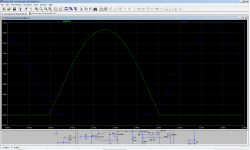Choke instead of a capacitor in the local OOS, try using 0.5-1U . Several turns of 0.1-0.2 mm wire are wound on the housing of the R20 3-10 Ohm resistor
I knew at the end you are going to slap a coil on it 🙂
==================
Я знал, что в конце концов ты накинешь на него катушку 🙂
==================
Я знал, что в конце концов ты накинешь на него катушку 🙂
I knew at the end you are going to slap a coil on it 🙂
==================
Я знал, что в конце концов ты накинешь на него катушку 🙂
я и не снимал.
The loop gain increases, the anti-overload capacity increases, and intermodal modes drop.
Maxim, did you try to simulate with speaker capacity added (e.g. 10nF) ?
Please try to simulate square waves with 10nF capacity added, and WITHOUT RL
network at the output.
Please try to simulate square waves with 10nF capacity added, and WITHOUT RL
network at the output.
With deep OOS, the response to capacitance is like all such amplifiers . With a multi-loop nested OOS, it is more stable. The more powerful the VC,the more pairs, the better
I tried, and on this amp it's impossible to get any kind of non-oscillating square waves without output RL, if even 10n capacitance is added to the speaker.
==================
Я попробовал, и на этом усилителе невозможно получить какие-либо неосциллирующие прямоугольные волны без выходного RL, если к динамику добавить даже 10n емкости.
==================
Я попробовал, и на этом усилителе невозможно получить какие-либо неосциллирующие прямоугольные волны без выходного RL, если к динамику добавить даже 10n емкости.
Yeah, that's the conclusion: RL is a must on this amp.
2uH + 3 Ohm seems to be working fine.
Caps (C11/C12) can go down to 47pF (from 120pF in my last sim), and Thd at 1kHz is 0 (zero) with 2 pairs of HexFets.
2uH + 3 Ohm seems to be working fine.
Caps (C11/C12) can go down to 47pF (from 120pF in my last sim), and Thd at 1kHz is 0 (zero) with 2 pairs of HexFets.
Attachments
Last edited:
OK, that's it. Moving on to the PCB design.
======
ОК, вот и все. Переходим к дизайну печатной платы.
======
ОК, вот и все. Переходим к дизайну печатной платы.
ок.Well. . I will work with the composite in "B" mode for now. On a pair of opamps
Last edited:
Please have a look at this plot: this is current flowing through output devices of the quasi hexfet amp.
Upper devices have 'rounded' edges around 0.0V (bottom of the plot), lower devices turn off sharply.
Upper devices are conduction more/longer than lower devices.
Why the difference? Is it good or bad?
Upper devices have 'rounded' edges around 0.0V (bottom of the plot), lower devices turn off sharply.
Upper devices are conduction more/longer than lower devices.
Why the difference? Is it good or bad?
Attachments
Outputs:
Upper: 94mA
Lower: 92mA
The bigger the idle current - the upper device conducting longer and longer.
Lower device - no difference.
Drivers:
Upper: 24mA
Lower: 28mA
Upper: 94mA
Lower: 92mA
The bigger the idle current - the upper device conducting longer and longer.
Lower device - no difference.
Drivers:
Upper: 24mA
Lower: 28mA
Last edited:
If I lower idle current (say 20mA per device) these difference in conducting are very small, but still there...
Question: is it good or bad?
I guess it shouldn't hurt if they overlap a little bit..
Question: is it good or bad?
I guess it shouldn't hurt if they overlap a little bit..
>Try placing a capacitor between the emitters of the drivers
It's oscillating with a cap. I tried 1uF and 100nF. Same behavior.
My guess is it's caused by LEDs added by Steve.
It does lower Thd (by half), so perhaps it's OK...
This is kind of experimental-quasi topology 🙂
==============
Он колеблется с крышкой. Я пробовал 1 мкФ и 100 нФ. Такое же поведение. Я предполагаю, что это вызвано светодиодами, добавленными Стивом. Он снижает Thd (вдвое), так что, возможно, все в порядке ... Это своего рода экспериментально-квазитопология.
It's oscillating with a cap. I tried 1uF and 100nF. Same behavior.
My guess is it's caused by LEDs added by Steve.
It does lower Thd (by half), so perhaps it's OK...
This is kind of experimental-quasi topology 🙂
==============
Он колеблется с крышкой. Я пробовал 1 мкФ и 100 нФ. Такое же поведение. Я предполагаю, что это вызвано светодиодами, добавленными Стивом. Он снижает Thd (вдвое), так что, возможно, все в порядке ... Это своего рода экспериментально-квазитопология.
Last edited:
- Home
- Amplifiers
- Solid State
- Unusual amp from 1987
